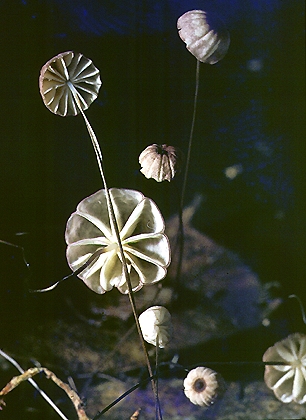
Marasmius crinisequi F.Muell.
Common name: Horse-hair Fungus; from the black, horse hair-like rhizomorphs which the fungus uses to spread through the litter.
Description: This species is more often found as the black rhizomorphs rather than as the tiny toadstool fruiting bodies that are produced. The black rhizomorphs are frequently found in a tangle over and through the rainforest litter, and in moist areas they will often move up into low shrubs and grow through the branches. If found, the tiny toadstools grow directly on the rhizomorphs and the caps are about 24 mm in diameter and creamy white to pale brownish. The caps are convex and dry but usually have a depression at the centre in the middle of which is a tiny umbo. The surface of the cap is finely, radially plicate and the gills are white, adnate and far apart. The stems are black, smooth, about 0.51 mm thick and may be up to 3 cm long.
The spores measure 812 × 46 µm and are ellipsoidal to elongated drop-shape, smooth and colourless but white in mass.
Substratum: The blackish rhizomorphs are quite common in rainforest litter and often aerially into the branches of small shrubs; this also occurs in wet eucalypt forest or in cool-temperate rainforest. The species is not often seen as the tiny toadstool form, but when found it may be solitary or in small groups.
Distribution: Known from Queensland, New South Wales, Victoria and Tasmania.
Notes: There is still a problem over the name of this very distinctive species. Currently, it is called M. crinisequi but there is a possibility that an earlier name was M. equicrinis. The latter must be used if it is found to be the earliest valid name.

